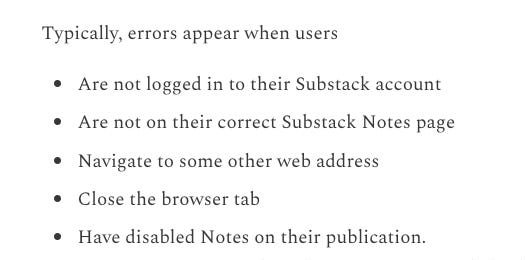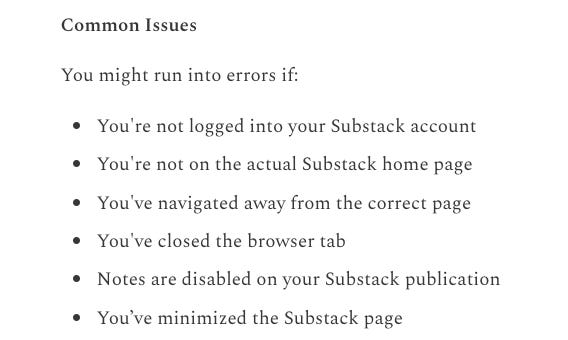This morning, I was feeling lazy—rain tapping the windows, my dog snoring on my shoulder, and me doom-scrolling Reddit like a professional.
Among the endless threads, I came across a discussion about scheduling Substack Notes. Now, this is a topic I know pretty well, having spent months building the #1-selling Substack Notes Scheduler and helping hundreds of users along the way.
Then I clicked a link.
And nearly dropped my coffee.
My work hadn’t just inspired someone—they had copied my product description word for word, slapped it onto a "new" Gumroad listing, and launched a simplified knockoff of my software.
I mean, sure, people say imitation is the sincerest form of flattery, but this was starting to feel like identity theft with a side of laziness.
And honestly? I was weirdly proud. I thought, “Finn, you’re not just shouting into the void anymore—you’re officially an artist. Your work’s good enough to steal. Congratulations!”
Copy-Pasta Product Description
As I clicked the link, there was a strangely familiar product description. My first thought?
"Wait - is that my masterpiece?"
I rubbed my eyes, checked the URL, and yep—this creator had taken my words, all of them, and just plopped them onto their Gumroad page as if they were their own. The nerve!
I couldn’t help but marvel at the efficiency.
This creator had somehow used my insights from analyzing 1.3 million Notes to make the argument that Substack creators who post 3-5 Notes daily see up to 10 times more engagement and a significant increase in paid subscriptions.
And that’s when I had a revelation: "Wow, the amount of research this creator has done here was about 0.8 seconds—the exact time it takes to perform a copy-paste operation."
For example, here's a little gem from my original description:
"Notes are the best discovery tool for over 30 million Substack users to find your newsletter—data from 1.3 million Notes shows that posting only a few more monthly Notes on average will help you grow your engagement and paid subscribers by 10X over time"
And here’s the "new and improved" version on Gumroad:
"Over 30 million Substack readers use Notes to discover new writers. Based on insights from 1.3 million Notes, creators who post 3-5 Notes daily see up to 10x more engagement and a significant increase in paid subscribers over time."
Just as effective, right? But hey, what’s a tiny detail like real data when you can copy-paste your way to success?
It gets better—this creator even copied my note about custom domains that used to be a problem for Substackers. I had written:
"NOTE: If you have a custom Substack domain, some users have reported problems with scheduled posts. Please reach out to finntropy@gmail.com before purchasing if you have a custom domain."
And here’s how it showed up on their page:
"Custom Domains: If your Substack uses a custom domain, you might run into issues with scheduled posts. Please DM <redacted> on substack before purchasing so we can help."
Ah, yes, the "new and improved" version—because when you copy and paste, you copy all the bugs and problems, too.
Now, let's talk about the user guide.
Cloning the User Guide
If there’s one thing that made me truly impressed (and slightly concerned), it’s how closely this creator’s guide mirrored mine, down to the last troubleshooting tip.
I was amazed that at the launch, they had already encountered all the same common issues that I had helped my software users solve over the last five months.
So much so, they had actually included them in their user guide. Here’s an example from my original user guide:
And guess what? Here’s the same section from their user guide:
I was over here like, "Wow, this creator gets me!" I mean, I guess it’s nice to know my user guide is so helpful that someone thought it was worth passing off as their own.
But wait, there’s more! They even managed to copy a super-specific troubleshooting case I had worked through with one of my customers. Here's what I originally wrote:
"You can go to your Substack Settings menu and check “Enable notes tab” / Show your notes in a new tab on your publication website."
And here's their version:
"To check if Notes are enabled, go to your Substack Settings and make sure “Enable notes tab” is checked. This will allow Notes to show up in a separate tab on your publication site."
At this point, I was just floored. I had walked a customer through these troubleshooting steps months ago, and now it was being presented as a "fresh insight" in their guide.
It’s like they took all the lessons I’ve learned, polished them up, and gave them away for free in their name. Awe-inspiring new user guide that packs in everything I’ve taught, just wrapped in a shiny new layer of 'pretend I wrote this myself' polish.
The Drama of the Digital World
If you create anything online, someone is eventually going to copy you. It’s practically a rite of passage—like getting your first bad haircut or falling for a phishing email.
It’s not just us, either. Photographers get their shots slapped on cheap mugs, musicians find their songs butchered into ringtones, and writers? Well, we get lovingly Ctrl+C'd by strangers with big dreams and small keyboards.
Digital theft is the sincerest form of flattery if you enjoy compliments delivered via blatant plagiarism.
Thinking of launching your own "original" product? Here’s the four-step plan:
Copy everything, but replace it with an emoji.
Remove anything useful—simplicity!
Pretend it was super hard.
Post a humblebrag about your “journey.”
Welcome to the creator economy.
The Revenge of the Original Content Creator
So, how am I handling all this?
With a cocktail of sarcasm, optimism, and a sprinkle of buttery popcorn.
These copy/paste creators have no idea that launching a product is only about 20% of the battle. The real work?
Providing 24/7 customer support. This is hard even if you don’t have a 9-to-5 job.
Troubleshooting weird, customer-specific bugs at midnight. Debug issues that might have nothing to do with your software.
Listening to the pain points users are expressing, and rolling out new features based on actual user feedback.
If you’re too lazy even to write your own product description, what message does that send to potential buyers?
“Hey, trust me with your money - I couldn't be bothered to even type this myself!”
Also, serious question: do they offer a 30-day no-questions-asked money-back guarantee, like I do? Something tells me the only guarantee they offer is ghosting after you make a purchase.
My next step?
I’m seriously considering releasing a free ebook called "How Not to Copy Product Descriptions: A Beginner’s Guide to Doing the Bare Minimum."
Stay tuned. It’s going to be a bestseller unless someone copies that, too.
Final Thoughts
Being a creator online is like hosting a party where someone always sneaks in, steals your playlist, and claims they made it. Annoying? Yes. But also, oddly flattering. If someone’s copying you, it means you’re doing something worth noticing.
So, what do you do?
You keep creating.
You innovate.
You stay two steps ahead.
Because while they’re busy copying your last move, you’re already working on your next big thing.
And to all the copycats out there: thanks for the compliment. Just remember, 80% of the hard work starts when you get the first customer.
If you’ve ever had your work copied, borrowed, or “heavily inspired,” tell me your story! I'd love to hear it—and maybe we can turn all that creative chaos into something hilarious and a little bit legendary.








There's a bunch of people out there who thinks that they can shortcut their way to "success". They want to get results without putting the effort.
I'm not going to name nationalities where they seem to come in hordes and I unfortunately found out that they exist a few years ago during my time as a creator on Twitter.
They built this super elaborate structures to steal other people's courses, upload them to a torrent site, and then build a website where they sell them at a cheaper price. All under the pretense they are "helping" people because the original content is too expensive for people like to afford it.
Even worse, they hide behind anonymous accounts and spam others trough Telegram groups trying to make their quick bucks.
Looks like you're famous enough, Finn. And your work is so valuable than one of those lazy bastards chose to plagiarize your work.
The majority are seeking competitive advantage. However, authenticity makes us unique and sets us apart from the rest. This is how to stay ahead of the competition💪while keeping in mind safeguarding intellectual property and copy written materials. When we learn better we do better